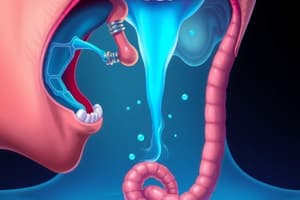Podcast
Questions and Answers
What is mastication?
What is mastication?
Mastication is the preparation of food by chewing for deglutition and digestion.
How does saliva help in food mastication?
How does saliva help in food mastication?
Saliva softens and lubricates food.
What are the muscles involved in mastication?
What are the muscles involved in mastication?
Temporalis, Masseter, Lateral pterygoid, Medial pterygoid, Suprahyoid, Infrahyoid, Buccinator.
What is the mnemonic for the muscles of mastication?
What is the mnemonic for the muscles of mastication?
What are the possible planes of movement of the mandible?
What are the possible planes of movement of the mandible?
What mandible movements are involved in the opening of the jaws?
What mandible movements are involved in the opening of the jaws?
How does the opening/depression of the mandible occur?
How does the opening/depression of the mandible occur?
How does the further depression and protrusion of the mandible occur?
How does the further depression and protrusion of the mandible occur?
How does the jaw close?
How does the jaw close?
What muscles perform jaw closure?
What muscles perform jaw closure?
What is the resting position of the jaw?
What is the resting position of the jaw?
How big is the freeway space in resting position?
How big is the freeway space in resting position?
What creates/allows the freeway space?
What creates/allows the freeway space?
What is considered the normal or right jaw position?
What is considered the normal or right jaw position?
Explain lateral deviation.
Explain lateral deviation.
How does lateral deviation occur to the left?
How does lateral deviation occur to the left?
What is the power stroke of the mandible?
What is the power stroke of the mandible?
What muscles are involved in the power stroke?
What muscles are involved in the power stroke?
What is deglutition?
What is deglutition?
What muscles are involved in deglutition?
What muscles are involved in deglutition?
How does the food bolus exit the oral cavity proper and enter the pharynx?
How does the food bolus exit the oral cavity proper and enter the pharynx?
Flashcards are hidden until you start studying
Study Notes
Mastication
- Preparation of food involves chewing, breaking larger pieces into smaller ones, enhancing surface area for digestion.
- Essential for deglutition (swallowing) and digestion.
Role of Saliva
- Softens and lubricates food, facilitating mastication.
Muscles of Mastication
- Key muscles include:
- Temporalis
- Masseter
- Lateral pterygoid
- Medial pterygoid
- Suprahyoid
- Infrahyoid
- Buccinator
- Mnemonic: "Inform Me To Masticate, Lubricate & Swallow Bolus's."
Mandible Movement
- Possible movements:
- Elevation/Depression
- Protrusion/Retrusion
- Side to side excursion.
Jaw Opening Mechanics
- Involves depression and protrusion of the mandible.
- Initial rotation occurs in the lower compartment of the temporomandibular joint (TMJ) led by the lateral pterygoid muscle.
- Following rotation, the upper compartment facilitates gliding of disc and condyle down the articular eminence.
Further Mandible Depression and Protrusion
- Achieved through the action of hyoid muscles, particularly anterior suprahyoid muscles.
- Posterior suprahyoid and infrahyoid muscles stabilize the hyoid bone.
Jaw Closure
- Reverses the opening sequence, involving retrusion and elevation of the mandible.
Muscles Involved in Jaw Closure
- Contraction of:
- Masseter
- Temporalis
- Medial pterygoid muscles.
Resting Position
- Relaxed state of the jaw where teeth are not constantly occluded.
- Freeway space measures 2-4 mm, generated by muscular balance and proprioceptive feedback.
Normal Jaw Position
- Classified as Class 1, Division 1 protrusion.
- Characterized by the upper first molar's mesialbuccal cusps between the corresponding cusps of the lower molar.
Lateral Deviation
- Non-identical side-to-side movement of the mandible involving coordination between the left and right TMJ.
Lateral Deviation to the Left
- Right lateral pterygoid muscle contraction causes rotation and forward movement of the right condyle, resulting in left deviation of the mandible.
Power Stroke of the Mandible
- Movement from a laterally deviated position back to the midline during chewing.
Muscles Involved in Power Stroke
- Pterygoid muscles and the posterior portion of the temporalis on the same and opposite sides.
Deglutition
- Coordinated action of tongue, soft palate, mastication, and suprahyoid muscles moving food from the oral cavity to the pharynx, esophagus, and stomach.
Muscles in Deglutition
- Teeth stabilization achieved by bilateral contraction of mandibular elevators.
- Tongue muscles: palatoglossus, styloglossus, and intrinsic tongue muscles work simultaneously.
Food Bolus Passage to Pharynx
- Tongue presses against the palate, reducing oropharyngeal isthmus.
- Soft palate lifted by palatopharyngeus, levator veli palatini, and uvulae muscles, closing off nasopharynx.
- Suprahyoid muscles elevate the hyoid bone and aid bolus passage.
- Pharyngeal muscles elevate the pharynx and larynx, driving food towards the esophagus, while the epiglottis closes the larynx to safeguard the respiratory pathway.
Studying That Suits You
Use AI to generate personalized quizzes and flashcards to suit your learning preferences.




